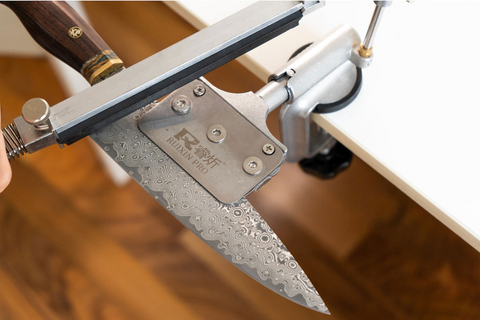A Guide to Sharper Knives
Blunt blades are unsafe and impractical. Keeping your knives sharp is vital to ensure stability, precision, and a safe environment in the kitchen. Worry not. From the complex and expensive to the time friendly and easy, we’ve outlined the multiple ways to sharpen your knives below. Keep reading to learn more.
Iki Ruixin Pro
The Iki Ruixin Pro is our preferred sharpening tool. This unique aluminium alloy concoction is durable, high quality, and designed to make sharpening your knives a breeze by eliminating the need to adopt a free hand approach.
It’s a simple but effective mechanism. To use it, first clamp it to your table and insert a whetstone of your choice; it comes with four different grits of whetstone. Next, insert your knife and use a protractor or your smartphone to set the angle. The angle can be set anywhere between 10 and 50 degrees. Finally, begin to perform the grinding motion. Flip it, and repeat. It’s really that easy.
Helpfully, it's memory function means that on your subsequent uses, your preferred angle will be retained, thereby keeping your knives razor sharp. Plus, the included whetstones use water for sharpening, meaning that you won’t need to dig deep into your pocket and buy expensive oils for the job.
Whether you’re an expert or have zero previous experience sharpening knives, the Iki Ruixin Pro is an ergonomic, time-efficient investment.
Whetstone
Another popular knife sharpening method is the whetstone. The method is perfectly capable of effectively sharpening your knives. Whetstone is available in multiple forms, from synthetic to natural. It features a coarse grit on one side, and a fine grit on the other. Whilst the angle varies for different knives, the general angle used is about 15-22 degrees.
The process is as follows. First, place your whetstone with the coarse side facing upwards and hold your knife at a 22 degree angle. Next, slide the full length of the knife’s blade across the whetstone around ten times on each side, retaining the 22 degree angle and keeping the whetstone stable and unmoved the entire time. Flip the whetstone over and repeat the process with the fine grit side.
Remember, all knives are different so be sure to do your due diligence and find out which angle the manufacturer of your knife recommends.
No doubt, using a whetstone can be tricky to execute and master. Unlike the Iki Ruixin Pro, a traditional whetstone requires you to manually keep the correct angle for the entire sharpening process. Keeping a steady hand can be tough, and be warned, you may compromise a few blades as you practice.
That said, when done right, it’s an effective sharpening method, so if you’re up for the challenge, check out our whetstone options:
Sharpening Steel
The sharpening steel is a long time go-to method for knife sharpening.
To use it, simply hold your knife in one hand with the sharp edge facing downwards, and the steel in your other hand. Create a crossing motion between the two, whilst keeping the knife at around a 22 degree angle; as with the whetstone, the angle will vary depending on the knife. Pull the knife across the sharpening steel up to 5 times, keeping the intended angle as a constant. Repeat this process on the other side of the blade.
As with a whetstone, it’s worth noting that the sharpening steel requires a free hand approach which can be difficult to maintain throughout the course of a sharpening session. To help with this, our Rosewood Sharpening Steel is user-friendly, at 9 inches in size. Plus, it features a handle made entirely of rosewood, enabling its user to grip it well.
Strop
Finally, a strop, often made of leather, is the perfect accessory to finish off the knife sharpening process. Once you have sharpened your knife with a whetstone, the Iki Ruixin Pro, or any other method for that matter, a burr, i.e. super thin edge on your blade, is created. Although it’s minute in nature, it’s powerful enough to quickly dull your blade. Hence, removing it is key for your knife's longevity.
Enter the Strop. Simply pull your knife inward at a fixed angle over the strop up to six times. Our Leather Strop has been treated with a green abrasive paste that is even more robust than steel, hence, the end result is smooth and free of inconsistencies.
Summary
The predominant methods of knife sharpening include using a whetstone, a sharpening steel, and the Iki Ruixin Pro. Our favorite of the three remains the Iki Ruixin Pro, simply due to the ease by which the user can lock in their chosen angle. Whetstones and sharpening steels are effective too, with real potential to result in razor-sharp end products.




